 W
WThe AAC Honey Badger PDW is an integrally suppressed personal defense weapon based on the AR-15. It is chambered in .300 AAC Blackout and was produced by Advanced Armament Corporation (AAC). The weapon is named after the honey badger.
 W
WThe ADCOR A-556 is an assault rifle based on the M16/M4 series. It is produced by the Adcor Defense Company and was one of the contenders in the US Army Individual Carbine Competition to replace the M4 Carbine.
 W
WAn AR-15 style rifle is a lightweight semi-automatic rifle based on the ArmaLite AR-15 design, which is itself a scaled-down derivative of Eugene Stoner's AR-10 design. The then Fairchild Engine and Airplane Corporation division ArmaLite sold the U.S. Patent 2,951,424 and trademarks to Colt's Manufacturing Company in 1959, but after Colt's gas operated bolt and carrier system patents expired in 1977, Colt retained the trademark and is the exclusive owner of the "AR-15" designation.
 W
WThe AR-57, also known as the AR Five Seven, is available as either an upper receiver for the AR-15/M16 rifle or a complete rifle, firing 5.7×28mm rounds from standard FN P90 magazines. It was designed by AR57 LLC was produced by AR57 of Kent, Washington, USA. The company is now defunct. The AR-57 PDW Upper is a new design on AR-15/M16 rifles, blending the AR-15/M16 lower with a lightweight, monolithic upper receiver system chambered in FN 5.7×28mm. This model is also sold as a complete rifle, supplied with two 50-round P90 magazines. The magazines mount horizontally on top of the front handguard, with brass ejecting through the magazine well. Hollow AR-15 magazines can be used to catch spent casings.
 W
WThe Ares Defense Shrike 5.56 is an air-cooled, dual-feed rifle for semi or full-auto configurations that fires the 5.56×45mm NATO cartridge. The Shrike 5.56 can be supplied as a complete weapon, or as an upper receiver “performance upgrade kit” to existing M16-type service rifles and carbines. it is named after the Shrike, a carnivorous passerine bird.
 W
WThe ArmaLite AR-10 is a 7.62×51mm NATO battle rifle developed by Eugene Stoner in the late 1950s and manufactured by ArmaLite, then a division of the Fairchild Aircraft Corporation. When first introduced in 1956, the AR-10 used an innovative straight-line barrel/stock design with phenolic composite and forged alloy parts resulting in a small arm significantly easier to control in automatic fire and over 1 lb (0.45 kg) lighter than other infantry rifles of the day. Over its production life, the original AR-10 was built in relatively small numbers, with fewer than 10,000 rifles assembled. However, the ArmaLite AR-10 would become the progenitor for a wide range of firearms.
 W
WThe ArmaLite AR-15 is a select-fire, air-cooled, gas-operated, magazine-fed rifle manufactured in the United States between 1959 and 1964, and adopted by the United States Armed Forces as the M16 rifle. Designed by American gun manufacturer ArmaLite in 1956, it was based on its AR-10 rifle. The ArmaLite AR-15 was designed to be a lightweight rifle and to fire a new high-velocity, lightweight, small-caliber cartridge to allow infantrymen to carry more ammunition.
 W
WThe Barrett REC7 is an American firearm manufactured as a selective-fire fully-automatic and semi-automatic rifle by Barrett Firearms. It is an M4 carbine utilizing a short-stroke gas piston system. REC7 is available in either 5.56×45mm NATO or 6.8mm Remington SPC. The REC7 is Barrett’s second AR-pattern rifle chambered for the 6.8mm Remington SPC cartridge, the first being the Barrett M468 rifle. The 6.8 SPC-chambered M468 rifle employed the same direct gas-impingement system as the M4.
 W
WThe Bushmaster XM-15 series is a line of AR-15 style semi-automatic rifles, and carbines, manufactured by Bushmaster Firearms International. Variants include the Bushmaster M4-type Carbine, Patrolman series, QRC series, Bushmaster XM15-E2S and the Carbon 15 line.
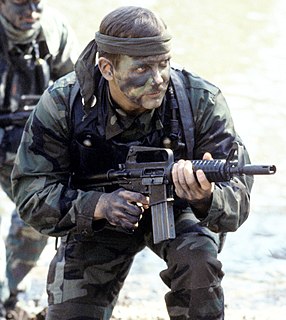 W
WThe Colt Automatic Rifle-15 or CAR-15 was a family of M16 rifle based firearms marketed by Colt in the 1960s and early 1970s. However, the term "CAR-15" is most commonly associated with the Colt Commando (AKA: XM177); these select-fire carbines have ultrashort 10.5-inch (270 mm) and 11.5-inch (290 mm) barrels with over-sized flash suppressors.
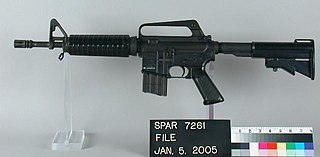 W
WThe CAR-15 XM177 or CAR-15 Commando was a part of the CAR-15 Military Weapons System designed in 1966 in response to the US military's desire for a compact M16 variant to improve on the inadequacies of earlier shortened M16 types.
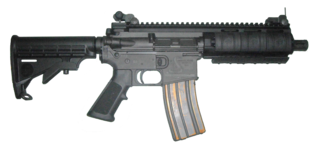 W
WThe Carbon 15 is a family of lightweight, magazine-fed pistols, carbines, and rifles developed by defunct United States weapons manufacturer Professional Ordnance, with the design picked up after some time by current manufacturer Bushmaster Firearms.
 W
WThe Close Quarter Battle Receiver (CQBR) is a replacement upper receiver for the M4A1 Carbine, developed by the US Navy.
 W
WThe Colt 9mm SMG, also known as the Colt Model 635 , is a 9×19mm Parabellum submachine gun manufactured by Colt, based on the M16 rifle.
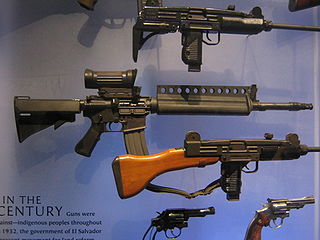 W
WThe Colt ACR was Colt's entry in the U.S. DoD Advanced Combat Rifle program, which concluded with the result that none of the entrants achieved enough of an improvement over the M16 to be worth the cost.
 W
WThe Colt AR-15 is a lightweight, magazine-fed, gas-operated semi-automatic rifle. The "AR” stands for the first two letters of ArmaLite. It was designed with the extensive use of aluminum alloys and synthetic materials to reduce weight. Colt's Manufacturing Company currently uses the AR-15 trademark for its line of semi-automatic AR-15 rifles.
 W
WThe Colt CM901 is a modular selective-fire rifle. Its caliber and barrel length can be changed without the use of tools. Its semi-automatic variant is the LE901-16S.
 W
WThe 10" Personal Defense Weapon (PDW) is a carbine made by the Government Arsenal of the Philippines, based on the M4 carbine/M16 rifle. It cycles fully automatic with specially developed 7.62×37mm Musang subsonic and supersonic rounds.
 W
WThe Heckler & Koch HK416 is a gas-operated assault rifle that is chambered for the 5.56x45mm NATO cartridge. It is designed and manufactured by the German company Heckler & Koch.
 W
WThe Heckler & Koch HK417 is a battle rifle and designated marksman rifle. It is designed and manufactured by Heckler & Koch in Germany.
 W
WThe Knight's Armament Company 6×35mm PDW is an experimental personal defense weapon designed by Knight's Armament Company (KAC), firing a 6mm cartridge optimized for short barrel weapons. A variant chambered in .300 AAC Blackout is also available.
 W
WThe SR-25 is a designated marksman rifle and semi automatic sniper rifle designed by Eugene Stoner and manufactured by Knight's Armament Company.
 W
WThis article describes the many variations of the Colt AR-15 and M16 rifle family of weapons produced by Colt's Manufacturing Company. Weapons patterned on the original ArmaLite AR-15 design have been produced by numerous manufacturers and have been used by nations around the world, some of which created their own variations. The tables here are split in a variety of categories, and provide an overview of different subtypes. For purposes of these tables, bold model numbers are weapons used by the U.S. Military while italic model numbers are weapons for commercial or export sale. See Glossary of terms for an explanation of each column.
 W
WThe M6 is a series of carbines designed and manufactured by LWRC International. It is based on the M4 carbine, with which it shares 80% of its parts. The 'M' model name is not a US military designation. Like the HK416, it features a proprietary short-stroke self-regulating gas piston system and bolt carrier/carrier key design, which prevents trapped gases from contacting the bolt carrier or receiver of the weapon, which reduces the heating and carbon fouling of the internals, simplifies field maintenance, and improves reliability.
 W
WThe M4 Carbine is a 5.56×45mm NATO, air-cooled, gas-operated, direct impingement, magazine-fed, select fire carbine. It has a 14.5 in (370 mm) barrel and a telescoping stock. It is essentially a lighter and shorter variant of the M16A2 assault rifle.
 W
WThe M16 rifle, officially designated Rifle, Caliber 5.56 mm, M16, is a family of military rifles adapted from the ArmaLite AR-15 rifle for the United States military. The original M16 rifle was a 5.56 mm assault rifle with a 20-round magazine.
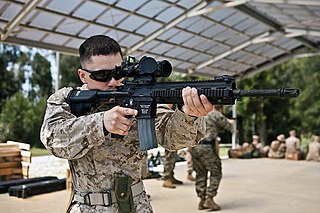 W
WThe M27 Infantry Automatic Rifle (IAR) is a lightweight magazine-fed 5.56mm select-fire weapon based on the HK416 rifle designed and manufactured by the German company Heckler & Koch. It is used by the United States Marine Corps (USMC) and is intended to enhance an automatic rifleman's maneuverability. The USMC initially planned to purchase 6,500 M27s to replace a portion of the M249 light machine guns employed by automatic riflemen within Infantry and Light Armored Reconnaissance Battalions. Approximately 8,000–10,000 M249s will remain in service with the Marine Corps to be used at the discretion of company commanders. In December 2017, the Marine Corps announced that it would equip every member of an infantry squad with the M27.
 W
WThe M110 Semi Automatic Sniper System is an American semi-automatic precision rifle that is chambered for the 7.62×51mm NATO round. It is manufactured by Knight's Armament Company, developed from the Knight's Armament Company SR-25, and adopted by the U.S. military following the 2005 US Army Semi-Automatic Sniper Rifle competition. The M110 is to be replaced by the lighter and more compact M110A1 CSASS, which is developed from the G28, a variant of the Heckler & Koch HK417.
 W
WThe Marine Scout Sniper Rifle or MSSR is a semi-automatic designated marksman rifle developed from the Colt M16A1 rifle by the Philippine Marine Corps Scout Snipers due to the lack of a dedicated precision rifle which is used in the Armed Forces of the Philippines.
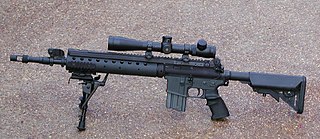 W
WThe United States Navy Mark 12 Mod 0/1 Special Purpose Rifle (SPR) is a semi-automatic designated marksman rifle that was in service with United States Special Operations Forces in the designated marksman role until 2017, also designed to be shorter than standard weapons. SPR initially stood for Special Purpose Receiver, but that nomenclature has been replaced as the weapon became a stand-alone weapons system, and not just an add-on upper receiver assembly.
 W
WThe MPT is a modular rifle family designed by MKEK and produced by MKEK, Sarsılmaz Arms and Kalekalıp to meet the demands of the Turkish Armed Forces and to replace its aging rifles such as the Heckler & Koch G3 and Heckler & Koch HK33 due to most of them being near the end of their service life. The MPT was designed for robust high altitude, all weather combat, capable of functioning in extreme hot and cold weather. The MKEK MPT is a rifle intended to take abuse and extreme mistreatment and still maintain high accuracy and reliability in order to survive in true battle environments. The Turkish government has invested US$22 million into the project.
 W
WThe Remington R4 is a firearms platform based on the AR-15/M16/M4/M4A1 series designed and manufactured by Remington Arms.
 W
WR5 RGP is a carbine that was designed and manufactured by Remington Arms. It is one of many AR-15 type rifles which uses a gas piston operating system in an attempt to improve the reliability of the weapon.
 W
WThe SIG MCX is a family of firearms designed and manufactured by SIG Sauer, produced in both selective fire and semi-automatic only models, and features a short-stroke gas piston system, which is inherited from the earlier SIG MPX submachine gun. The MCX is available in rifle, carbine, short-barreled rifle, and pistol configurations.
 W
WThe SIG Sauer SIG516 is a semi-automatic rifle manufactured by SIG Sauer. It is an AR-15 style rifle chambered in 5.56×45mm NATO. Introduced in 2010, the SIG516 was discontinued as of 2019. A variant chambered in 7.62x51mm NATO, the SIG716, remains in production.
 W
WThe Smith & Wesson M&P15 is an AR-15 style semi-automatic rifle by gun manufacturer Smith & Wesson. Introduced in 2006, the firearm is designed for police and consumer markets.
 W
WThe Smith & Wesson M&P15-22 is a .22 LR variant of the Smith & Wesson M&P15 semi-automatic rifle, but is blowback-operated rather than direct impingement-operated. It is intended for recreational shooting ("plinking") and small game hunting. It is made with a polymer upper and lower receiver rather than the aluminum alloy that is normally used in AR-15 style rifles, and uses proprietary polymer box magazines.
 W
WThe Special Operations Assault Rifle (SOAR) is an assault rifle manufactured by FERFRANS and designed as an improvement of the M4 carbine.
 W
WThe T65 is a rifle developed and manufactured by the Combined Logistics Command of the Republic of China Armed Forces in Taiwan. Originally patterned after the Armalite AR-18 that has a short-stroke gas system, the prototype unveiled in 1975 showed a rifle that is heavily influenced by the AR-15 family of rifles, albeit with modified iron sights, a reshaped stock, and redesigned handguards. The designated number '65' refers to the Year 65 of Republic of China (1976), the year the rifle's design was finalized. Upgraded versions were designated the Type 65K2 and Type 65K3.
 W
WThe T86 rifle is a gas-operated, magazine-fed, air-cooled assault rifle. It is the second original rifle design conducted by the 205th Armory of Combined Service Forces, Republic of China (Taiwan). Though it saw limited production and service after a protracted development process, it became the basis of the T91 Assault Rifle currently in volume production for the ROC armed forces.
 W
WThe T91 rifle is produced by the 205th Armory of the Republic of China Ministry of National Defense. It is based on the proven T86 assault rifle, incorporating features from the M16 and AR-18 rifles with more modern features. The T91 is lighter and shorter than the T65 it replaces and has a 3-position telescoping stock to allow adjustment based on individual requirements.
 W
WThe United States Army Squad Designated Marksman Rifle (SDM-R) is a heavily modified M16-series rifle intended to provide increased accuracy at longer ranges, giving infantry squads greater firepower.
 W
WThe Squad Advanced Marksman Rifle (SAM-R) was a semi-automatic designated marksman rifle developed and used by the United States Marine Corps. It gave users the capability to provide precision fire in support of a rifle squad, providing precision fire in support of an assault, and aid in observation and adjusting of supporting arms. The SAM-R was retired by the U.S. military in the mid-2010s and thus is no longer in service, having been replaced by the M27 IAR.